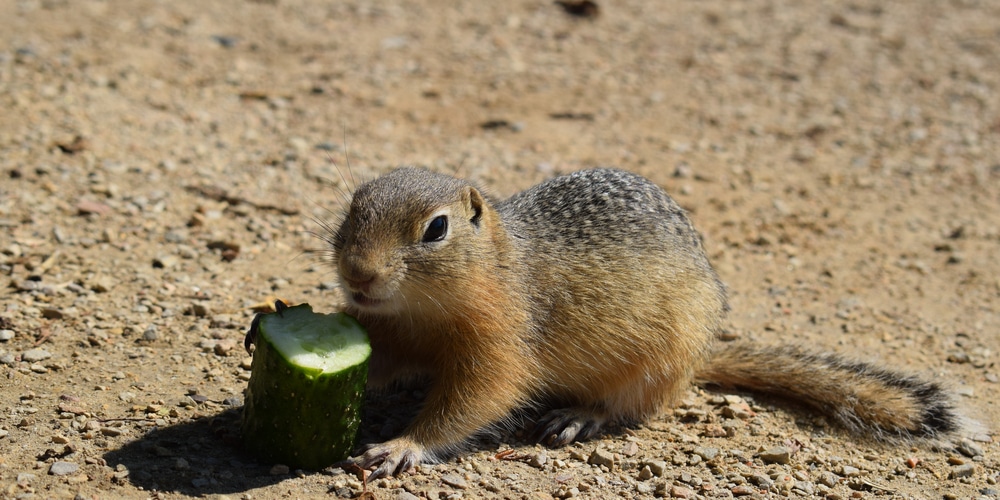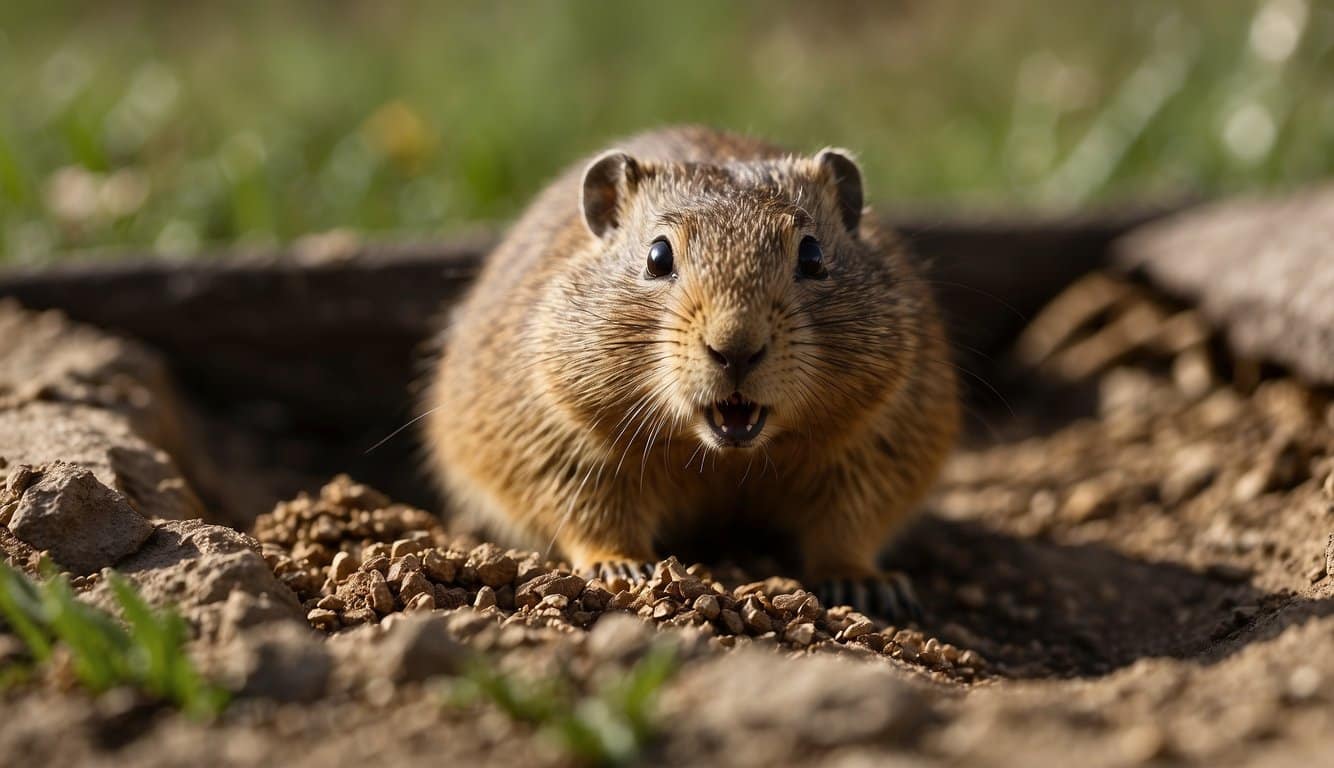Getting Rid of Gophers The Easy Way

Step 1: Confirm Gopher Presence
- Question: Have you noticed fresh mounds of dirt with a fan-shaped pattern, tunnels, or plant damage?
- Yes: Proceed to Step 2.
- No: Continue to monitor your yard for signs of gopher activity.
Step 2: Choose an Exclusion Strategy
- Action: Implement physical barriers if possible.
- Methods:
- Underground Fencing: Install wire mesh or hardware cloth around gardens. Bury at least 18 inches deep with a few inches bent outward in an “L” shape to deter digging.
- Plant Cages: Protect individual plants with underground baskets made from wire mesh.
- Methods:
Step 3: Use Humane Traps
- Question: Are you comfortable using traps?
- Yes: Set live traps or box traps near the freshest gopher mounds.
- Tips: Check traps frequently to deal humanely with any trapped gopher.
- No: Consider other non-lethal methods like repellents.
- Yes: Set live traps or box traps near the freshest gopher mounds.
Step 4: Apply Natural Repellents
- Action: Use natural gopher repellents.
- Options:
- Castor Oil Granules: Spread around the yard, especially near gopher activity. Castor oil is non-toxic and can deter gophers by making the soil unpleasant.
- Plant-Based Repellents: Plant gopher spurge or other plants known to repel gophers.
- Options:
Step 5: Employ Ultrasonic Devices
- Question: Would you like to try ultrasonic devices?
- Yes: Place ultrasonic stakes in the ground. These devices emit sounds and vibrations that are meant to irritate gophers and discourage them from the area.
- No: Stick with other methods like traps or repellents.
Step 6: Utilize Bait and Poison Methods
- Caution: Consider using poison only as a last resort due to the risk to other wildlife, pets, and children.
- Action: If you choose to use bait, select a product approved for gophers and follow all label instructions carefully.
- Placement: Place bait directly into gopher tunnels rather than above ground to target gophers specifically and reduce risk to other animals.
Step 7: Flood or Smoke Tunnels
- Question: Do local regulations allow flooding or smoking out gophers?
- Yes: Use water or smoke bombs to drive gophers out of their tunnels.
- Water: Insert a hose into the tunnel and turn on the water to flood the system.
- Smoke Bombs: Use according to manufacturer’s directions to fill tunnels with smoke, encouraging gophers to leave.
- No: Continue with other approved methods.
- Yes: Use water or smoke bombs to drive gophers out of their tunnels.
Step 8: Monitor and Adapt
- Routine Actions:
- Regular Inspections: Keep an eye on gopher activity. Check for new mounds or damage.
- Adapt Strategies: Adjust control methods as necessary based on the effectiveness and gopher behavior.
Step 9: Professional Pest Control
- Question: Is the gopher problem persistent and damaging despite efforts?
- Yes: It might be beneficial to hire a professional pest control service specializing in wildlife management for more effective solutions.
- No: Continue with effective measures and regular monitoring.
Additional Tips
- Regularly mow your lawn and manage weeds to decrease the attractiveness of your property to gophers.
- Maintain vigilance, especially during spring and fall when gopher activity typically increases.
Gopher Identification: Know Your Enemy
Before you declare war on these furry fiends, you’ll need to know exactly who you’re dealing with.
Get ready to become a gopher guru.
- Physical Traits: Gophers are medium-sized rodents, typically weighing around half a pound.
They boast brown fur that camouflages well with soil.
- Size: About 6 to 13 inches long, including the tail.
- Fur Color: Usually brownish, varies slightly.
- Distinguishing Features: These critters have small eyes and ears, with strong forelimbs and large, sharp claws for digging.
Look out for their telltale cheek pouches.
- Landscape Clues:
Sign Description Mounds Crescent or horseshoe-shaped. Soil Texture Fine, as if sifted through a screen. Plant Damage Sudden wilting due to severed roots.
By taking note of these characteristics and landscape signals, you’re on the right track to identifying your underground visitors.
Watch your step, those mounds aren’t just eyesores, they’re trip hazards!
Natural Gopher Repellents
When dealing with unwanted gopher guests, you can employ natural methods that effectively encourage these burrowing buddies to move on without harming them.
Let’s dig into some tried-and-true repellents that will send gophers packing.
Predator Urine and Scents
- Fox and Coyote Urine: These predators’ urine is like a red flag for gophers, signaling danger.
- Apply it around the perimeter of your garden.
- Peppermint Oil: Not just for fresh breath!
- Soak cotton balls in peppermint oil and drop them into gopher tunnels.
- Its pungent scent is a natural deterrent.
Each method should be reapplied periodically, especially after rainfall, to maintain its effectiveness.
Plant Deterrents
Certain plants work as fantastic gopher turn-offs and double as pretty additions to your garden. Here are a few to consider:
- Gopher Spurge (Euphorbia lathyris): This plant is as unwelcoming to gophers as a closed door, thanks to its roots that gophers find unappetizing.
- Marigolds and Daffodils: These beautiful flowers give off odors that gophers dislike.
- Plant them as border flowers around your garden.
Remember, planting these deterrents at the start of the season can help you stay one step ahead in the gopher game.
Creating Physical Barriers
To keep gophers at bay, physically blocking their access to your garden is a practical move.
It’s all about creating strong barriers so these critters can’t turn your green space into their personal playground.
Underground Fencing
- Materials: Choose hardware cloth or galvanized mesh with small openings (about 1/2 inch) to deter gophers effectively.
- Installation Depth: Bury the fencing at least 2 feet deep to prevent gophers from burrowing underneath.
- Benefits:
- Long-Term Solution: A properly installed underground fence offers enduring protection for your garden.
- Environmental Friendly: No harmful chemicals, so it’s safe for your plants and the local wildlife.
Raised Beds
- Construction: Use thick, solid wood or concrete blocks to build raised bed frames.
- Lining:
- Line the bottom with the same hardware cloth used in underground fencing.
- Ensure it’s securely attached to the sides of the bed to create a full barrier.
- Advantages:
- Enhanced Drainage: Raised beds promote better water drainage, which is great for plant health.
- Ease of Access: Gardening becomes less of a backache, thanks to the raised height.
Remember, these fortifications not only discourage gophers but also improve the overall tidiness and organization of your garden.
Get ready to reclaim your territory from those furry intruders!
Humane Trapping Techniques
Hey there, outdoor enthusiasts! If you’ve got a gopher party happening in your yard and you’re looking to send them packing – humanely, of course – then you’re in the right spot.
Let’s get straight into the do-gooder details of humane trapping techniques:
- Live Traps: These nifty devices allow you to catch those burrowing bandits without harm.
Position these traps near the entrances of gopher tunnels.
- Baiting the Trap: Opt for fresh veggies like carrots or lettuce to lure them in.
- And let’s be real – who can resist a fresh snack?
- Strategic Placement:
- Locate active tunnels by looking for fresh mounds of dirt.
- Set your traps in these active areas for a higher capture rate.
- Checking Traps: Always remember:
- Check traps at least twice a day to ensure gophers are not stressed for long periods.
- Provide food and water in the trap if your region’s guidelines advise doing so.
- After the Catch:
- Relocate promptly following local wildlife regulations.
- You’ll want to choose a new home for them far from residential areas—think “gopher paradise.”
Professional Gopher Extermination Services
When your yard becomes a gopher amusement park, it’s time to bring in the professionals. These critters might be cute from afar, but their ability to destroy a garden is nothing short of villainous.
Here’s why calling in professional gopher extermination services can be a game-changer for your landscape:
- Customized Solutions: Pros assess your specific situation and devise a plan that’s tailored just for you.
- They might employ strategies such as trapping, baiting, or the use of exclusion devices.
- Efficiency: With years of experience under their belt, exterminators work swiftly to remove the problem, often with techniques and tools that are at the cutting edge.
- Follow-up: The best part?
- They don’t just pack up and leave after the initial extermination.
- Professionals ensure that your issue is resolved with ongoing monitoring.
What Can You Expect?
- Assessment: Get an in-depth evaluation of the gopher problem in your yard.
- Plan of Action: Receive a clear strategy outlining the extermination methods to be used.
- Execution: Watch as trained technicians work their magic without turning your yard into a warzone.
- Prevention: Learn how to deter future infestations, maintaining the sanctity of your green space.
Frequently Asked Questions
In this section, dig into the highly effective tactics for repelling those furry little invaders from your garden.
You’ll learn to employ nature’s gifts, handy household items, and smart landscaping to keep gophers at bay.
What are the most effective natural deterrents for gophers?
For natural gopher control, consider planting gopher-repellent plants like lavender, salvia, and rosemary in your garden.
These plants not only enhance your garden’s aesthetics but also act as a barrier against gophers.
Which humane methods can prevent gophers from invading the garden?
Humane gopher control starts with trapping and relocating.
Set up a live trap and once a gopher is caught, release it in a habitat far from residential areas to prevent re-entry into your garden.
Can household items be used to deter gophers, and if so, which ones are best?
Absolutely! Some household items like coffee grounds or dryer sheets can be used.
Sprinkle the coffee grounds around your garden or stuff the dryer sheets into gopher holes—they dislike the strong smells and will likely scram.
What are the best strategies for dealing with both gophers and moles?
When targeting both gophers and moles, combining sound and vibration devices with repellent plants offers a dual-pronged approach to dissuade these burrowers from your yard.
Which scents or plants can create a gopher-repellent garden environment?
Some scents and plants act as a natural gopher deterrent.
Creating a garden environment filled with olfactory irritants for gophers such as eucalyptus, peppermint oil, and the aforementioned gopher-repellent plants can be highly effective.
What modifications to the yard can dissuade gophers from making it their home?
Implementing certain yard modifications can make your garden less inviting to gophers.
This includes installing underground barriers, maintaining a tidy garden free of edible bulbs, and raising garden beds to disrupt easy tunneling.
Last update on 2024-05-18 / Affiliate links / Images from Amazon Product Advertising API





